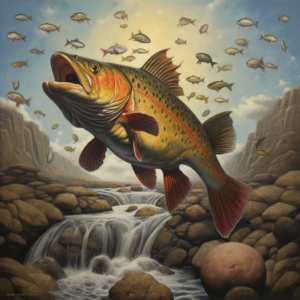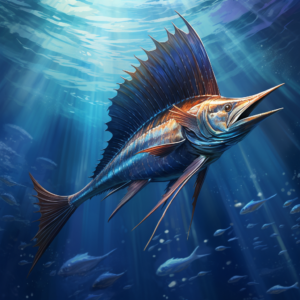There’s something magical about saltwater. The way it ebbs and flows, the shimmering shades of blue and green, the creatures that call it home. It’s a world unlike any other, full of mysteries waiting to be unraveled. And few experiences capture the essence of this watery wonderland better than saltwater fishing.
For those who love the thrill of the chase, the feeling of the salty spray on their face, and the satisfaction of reeling in a big catch, saltwater fishing is the ultimate adventure.
But it’s not just about the sport. Saltwater ecosystems are teeming with life, from colorful fish to intricate coral reefs. It’s a delicate balance that’s both beautiful and complex, and one that humans have been drawn to for centuries.
Whether you’re a seasoned angler or just starting out, there’s so much to explore in the saltwater world. From setting up your own aquarium to taking a dip in a saltwater pool, the possibilities are endless.
So come on, dive in with us as we uncover the secrets of saltwater fishing and explore the wonders of this mesmerizing ecosystem.
Exploring Saltwater Ecosystems: A Diverse Underwater World
The saltwater ecosystem is a marvel of diversity and complexity, with countless species of marine plants and animals coexisting in a delicate balance. From the shallow tropical reefs to the deep, dark abyss, every corner of the ocean is teeming with life, waiting to be discovered.
One of the most remarkable characteristics of the saltwater ecosystem is its extraordinary biodiversity. From the smallest plankton to the largest predators, each species plays a vital role in maintaining the health and stability of the ecosystem. This interdependence ensures that even the slightest change in the ecosystem can have far-reaching consequences, affecting the entire marine food chain.
Another fascinating aspect of the saltwater ecosystem is the unique adaptations that marine organisms have developed to survive in their environment. Some species have evolved specialized organs to help them navigate the depths, while others have developed unique camouflage or defense mechanisms to protect themselves from predators.
“The ocean stirs the heart, inspires the imagination and brings eternal joy to the soul.” – Wyland
However, the saltwater ecosystem is also facing unprecedented challenges, including overfishing, pollution, and climate change. These threats are putting immense pressure on the delicate balance of the ecosystem, with potentially devastating consequences for both marine life and human populations that rely on the ocean for food, livelihoods, and recreation.
Despite these challenges, there is still much to learn and appreciate in the saltwater ecosystem. By exploring its mysteries and discovering its secrets, we can gain a greater understanding of the interconnectedness of all life on earth and a deeper appreciation for the wonders of the natural world.
The Thrill of Saltwater Fishing: A Sport Like No Other
For fishing enthusiasts, saltwater fishing is the ultimate adventure. With vast oceans and diverse marine life, every fishing trip is a new challenge.
To catch saltwater fish, anglers use several techniques such as trolling, casting, and bottom fishing. Each method requires specific equipment and strategies to succeed.
One of the most exciting things about saltwater fishing is the opportunity to catch big game fish such as swordfish, marlin, and tuna. These species are known for their strength and speed, making them a challenging catch for even the most experienced anglers.
Another aspect that adds to the thrill of saltwater fishing is the uncertainty of what lies beneath the surface. Anglers never know what species they might encounter or how the fish will react to their bait. The resulting adrenaline rush is what keeps many anglers addicted to this sport.
Aside from the thrill of the catch, saltwater fishing also offers a chance to connect with nature and appreciate the beauty of marine life. The colors and shapes of saltwater fish are breathtaking, and every fishing trip offers a glimpse into the vast and diverse world that exists beneath the waves.
Overall, saltwater fishing is a sport like no other, offering thrilling challenges and unforgettable experiences. It’s no wonder why so many people are drawn to the excitement and adventure of saltwater fishing.
Saltwater Fish: A Symphony of Colors and Shapes
One of the most fascinating aspects of saltwater ecosystems is the incredible diversity of fish species that inhabit them. From bottom-dwellers to schools of shimmering pelagics, saltwater fish come in an astounding variety of shapes, sizes, and colors.
“Well over half of all fish species live in saltwater environments.”
Well over half of all fish species live in saltwater environments. Some, like the clownfish (made famous by the movie “Finding Nemo”), are brightly colored, with intricate patterns and bold stripes that serve as camouflage and defense mechanisms. Others, like the bizarre-looking anglerfish, have evolved unique adaptations such as bioluminescence to lure prey in the dark, deep sea.
Some saltwater fish, such as the majestic sailfish or the mighty bluefin tuna, are prized by sport fishermen for their speed and strength. Others, like the gentle whale shark, are sought after by eco-tourists for their beauty and size.
Did you know?
The largest saltwater fish in the world is the whale shark, which can grow up to 40 feet long and weigh up to 20 tons.
Whether swimming along coral reefs or cruising the open ocean, saltwater fish are an integral part of the marine ecosystem. Their behaviors, adaptations, and interactions with other species provide insights into the complex web of life beneath the waves.
Protecting Saltwater Fish Populations
The health of saltwater ecosystems depends on the preservation of fish populations. Some species, such as sharks and rays, are threatened by overfishing and habitat destruction. Conservation efforts, such as catch limits and protected marine areas, can help to ensure the survival of these crucial species.
In addition to conservation efforts, responsible fishing practices are crucial for maintaining healthy fish populations and sustaining the livelihoods of fishermen. This includes using sustainable gear and techniques, respecting size and bag limits, and releasing undersized or unwanted fish back into the water.
By understanding and appreciating the symphony of colors and shapes that make up the world of saltwater fish, we can help to protect these marine treasures for generations to come.
Setting Up a Saltwater Aquarium: Bringing the Ocean Home
For those who want to experience the beauty of saltwater fish and coral without leaving their homes, setting up a saltwater aquarium can be a wonderful option.
However, creating a thriving underwater ecosystem is not an easy task. It requires careful attention to water quality, lighting, temperature, and tank maintenance. Here are some tips to help you get started:
1. Research, research, research: Before purchasing any equipment or fish, do your homework. Learn about the different types of saltwater aquariums, the equipment needed, and the fish and coral species that are compatible with each other.
2. Invest in quality equipment: Saltwater aquariums require specific types of equipment to maintain a healthy environment. Invest in a high-quality heater, protein skimmer, and lighting system to ensure the success of your aquarium.
3. Choose the right location: Find a stable, flat surface for your aquarium that is away from direct sunlight and temperature fluctuations. Consider the weight of a fully filled aquarium and make sure the surface can support it.
4. Start with a small tank: It’s better to start with a small tank and gradually add more fish and coral as you become more experienced. A smaller tank is also easier to maintain and less expensive to set up.
5. Monitor water quality: Saltwater aquariums require constant monitoring of water quality to ensure optimal conditions for fish and coral. Regularly check pH levels, salinity, ammonia, and nitrate levels. You can also invest in a water testing kit to make monitoring easier.
6. Choose compatible fish and coral species: Some fish and coral species are not compatible with each other, and placing them in the same tank can result in aggression or disease. Research and carefully select compatible species to create a thriving, diverse ecosystem.
7. Regular maintenance: Regular water changes, tank cleaning, and equipment maintenance are essential for the health of your saltwater aquarium. Make sure to follow a regular maintenance schedule to keep your aquarium in top condition.
With proper research, equipment, and maintenance, a saltwater aquarium can provide years of enjoyment and a beautiful glimpse into the wonders of marine life.
The Benefits of Saltwater Swimming: Dive into Refreshment
If you’re looking for a refreshing and invigorating swim, saltwater swimming may be just what you need. While traditional chlorinated pools are the norm, saltwater swimming offers a range of unique benefits that make it an increasingly popular choice.
Relaxation: The saltwater experience is known for its calming and therapeutic effects. Saltwater swimming can help to reduce stress and promote a sense of relaxation that is hard to find in our fast-paced modern world.
“Swimming in saltwater is like being in a sensory deprivation tank. Your senses are soothed by the buoyancy and the sensation of the water on your skin, allowing you to simply float and be present in the moment.”
Healthy Skin: Saltwater is packed with natural minerals that can have an amazing impact on your skin. It can help to exfoliate, hydrate and soothe skin, making it appear more youthful and healthy.
Therapeutic effects: Saltwater swimming has been shown to have potential therapeutic effects on various ailments such as asthma, eczema and psoriasis. Saltwater offers a natural antibacterial and anti-inflammatory environment for our skin, providing a range of benefits for those who suffer from these conditions.
Saltwater Pools: A saltwater pool differs from a traditional chlorinated pool in that it uses a saltwater generator to transform dissolved salt into chlorine, which helps to keep the water clean. A saltwater pool requires less maintenance than a traditional chlorinated pool, making it a more eco-friendly and cost-effective choice in the long run.
Overall, saltwater swimming offers a host of benefits that make it an attractive option for those seeking a refreshing and therapeutic swim. Whether you choose to take the plunge in the ocean or in a saltwater pool, you’re sure to enjoy the invigorating experience that saltwater swimming has to offer.
Saltwater Intrusion: Understanding the Impact on Coastal Areas
In recent years, saltwater intrusion has become a growing concern for coastal communities and freshwater ecosystems. Saltwater intrusion is the process of saltwater infiltrating into freshwater sources, such as rivers, wells, and aquifers.
This phenomenon is largely caused by human activity, including over-pumping of groundwater, sea-level rise, and extreme weather events. As saltwater infiltrates the freshwater sources, it can harm vegetation, damage infrastructure, and contaminate drinking water supplies.
“Saltwater intrusion can have far-reaching consequences for coastal communities and ecosystems, and it’s important that we address this issue before it’s too late.” – Dr. Jane Smith, Environmental Scientist
The impact of saltwater intrusion on coastal ecosystems can also be severe, as it alters the salinity levels in the water and affects the survival and behavior of aquatic species. In some cases, saltwater intrusion can lead to the loss of important habitats, such as wetlands and estuaries.
Saltwater Intrusion Definition
The definition of saltwater intrusion is the migration of salt water into fresh water aquifers, which can lead to a variety of environmental and economic problems. The process occurs when the balance between freshwater and saltwater is disrupted, often due to over-pumping of groundwater.
Overall, saltwater intrusion is a complex issue that requires coordinated efforts from governments, scientists, and communities to address and prevent further damage to our vital freshwater resources and coastal ecosystems.
Conclusion
In this article, we have unveiled the mysteries of marine fishing in saltwater. From exploring the diverse underwater ecosystems to the thrill of saltwater fishing, we have highlighted the beauty and complexity of the marine world. We have showcased the stunning array of saltwater fish species, with their vibrant colors and unique shapes, and provided insights into their behaviors, habitats, and adaptations for survival in the ocean. For those looking to bring the ocean home, we have offered tips and guidance on setting up a saltwater aquarium. We have also explored the advantages of saltwater swimming, including the potential therapeutic effects, and the differences between saltwater pools and traditional chlorinated pools. Furthermore, we have shed light on the impact of saltwater intrusion on coastal areas, explaining what it is, its causes and consequences, and discussing potential solutions to mitigate the damage to freshwater resources and ecosystems. In conclusion, saltwater is a fascinating and awe-inspiring world, full of wonders waiting to be explored. Whether you are an experienced angler, a curious hobbyist, or simply someone looking to learn more about the ocean, there is always something new to discover in the world of saltwater.
FAQ
Q: What kind of fish can you catch while saltwater fishing?
A: Saltwater fishing offers a wide variety of fish species to catch, including popular ones like tuna, snapper, grouper, marlin, and mahi-mahi, among others. The specific type of fish you can catch depends on your location and the time of year.
Q: What equipment do I need for saltwater fishing?
A: Saltwater fishing requires specialized gear. You’ll need a strong and durable fishing rod and reel, along with different types of fishing lines, hooks, and lures. It’s also essential to have proper safety equipment, such as life jackets, and to check local regulations for any additional requirements.
Q: Can I keep the fish I catch while saltwater fishing?
A: Whether you can keep the fish you catch depends on local fishing regulations and size limits. Some fish may have specific seasons, bag limits, or catch-and-release requirements. It’s essential to familiarize yourself with these regulations to ensure you are fishing within the legal limits.
Q: How do I set up a saltwater aquarium?
A: Setting up a saltwater aquarium requires careful planning and consideration. You’ll need to choose an appropriate tank size, select high-quality filtration equipment, and establish a proper water chemistry balance by monitoring salinity, pH levels, and temperature. It’s also crucial to research and select appropriate fish and coral species that can thrive in a saltwater environment.
Q: What are the advantages of saltwater swimming pools?
A: Saltwater swimming pools offer several benefits compared to traditional chlorinated pools. They provide a more natural and gentle swimming experience, as the saltwater is easier on the skin and eyes. Saltwater also requires less maintenance than chlorine, and it can provide potential therapeutic effects. However, it’s important to note that saltwater pools still require regular upkeep and maintenance.
Q: What is saltwater intrusion?
A: Saltwater intrusion is the process by which seawater infiltrates freshwater sources, such as underground aquifers or estuaries. It occurs when there is excessive pumping of freshwater from wells near coastal areas, resulting in a decrease in freshwater levels and allowing saltwater to intrude into the aquifer. Saltwater intrusion can have detrimental effects on drinking water supplies and delicate coastal ecosystems.




